

PDF (Portable Document Format) files are an integral part of modern business workflows, providing a reliable way to present and share documents across various platforms while maintaining their original formatting. Integrating PDF handling capabilities into your applications can greatly enhance their functionality, but it’s essential to follow best practices to ensure efficient and error-free PDF manipulation. In this blog post, we’ll delve into the best practices for effectively working with PDF libraries in platforms like ASP.NET, MVC, .NET Core, Xamarin, Blazor, UWP, WPF, WF, WinUI, and .NET MAUI.


There is a plethora of PDF libraries available, each catering to different levels of complexity and functionality. When selecting a library, consider the following factors:
Features: Determine whether the library offers the features required for your project, such as PDF generation, modification, text extraction, form filling, encryption, etc.
Ease of use: Look for libraries with well-documented APIs and examples to minimize the learning curve.
Community support: Libraries with active communities tend to have better support, frequent updates, and a wealth of resources for troubleshooting.
Licensing: Ensure the library’s licensing model aligns with your project’s requirements, whether it’s open-source, commercial, or proprietary.
PDF manipulation often involves resource-intensive operations like file I/O, memory usage, and CPU processing. To manage resources efficiently:
Close resources properly: When working with files or streams, make sure to close them after you’re done to prevent memory leaks or conflicts with other processes.
PDF manipulation can be complex, and errors may occur due to various factors. Robust error handling ensures that your application gracefully handles unexpected situations:
Check for errors: Most PDF libraries provide methods to check for errors after performing operations. Always check these return values or exceptions to catch and handle errors promptly.
Logging: Implement thorough logging mechanisms to capture errors, warnings, and informational messages. This aids in debugging and troubleshooting.
Ensure that the PDF library you choose is compatible with the versions of the PDF format you need to work with. PDF standards evolve over time, and not all libraries may support the latest features.
PDF manipulation can sometimes be resource-intensive, especially when dealing with large documents. To optimize performance, use:
Lazy loading: When working with large documents, consider lazy loading or processing only required sections to minimize memory usage.
Caching: Cache frequently accessed data or generated PDFs to avoid redundant computations.
When dealing with sensitive information, security and privacy are paramount:
Data sanitization: Ensure that any data you insert into PDFs is properly sanitized to prevent injection attacks.
Encryption: If your application deals with confidential information, explore the library’s encryption capabilities to protect sensitive content.
PDF libraries are continuously updated to address bugs, security vulnerabilities, and to add new features. Regularly update your chosen library to benefit from improvements and maintain security.
Thorough testing is essential to ensure that your PDF manipulation features work as intended:
Unit testing: Create unit tests to cover different scenarios, edge cases, and error conditions.
Integration testing: Test the integration of PDF manipulation features within your application’s workflow.
Take advantage of the library’s documentation and available learning resources:
API documentation: Familiarize yourself with the library’s API documentation to understand its methods, classes, and usage patterns.
Tutorials and examples: Many libraries provide tutorials and code examples that can help you grasp complex concepts and implement features more effectively.
By embracing these recommended strategies, you equip yourself with the tools needed to effectively wield the capabilities of PDF libraries, resulting in the seamless incorporation of PDF manipulation features into your applications. An invaluable asset in this journey is the Syncfusion library—a potent resource that perfectly aligns with the principles we’ve highlighted.
With the adoption of the Syncfusion .NET PDF library, you open the door to an expansive toolkit that caters to your needs. This library offers a wealth of features, empowering you with robust capabilities for PDF generation, modification, and manipulation. Its user-friendly APIs, exhaustive documentation, and copious examples ensure that incorporating PDF-related functionalities into your applications becomes a straightforward endeavor.
In summation, the synergy between your adherence to these best practices and the prowess of the Syncfusion library empowers you to elevate your application’s prowess in handling PDFs to unparalleled heights. Whether your goal is to generate dynamic reports, streamline document workflows, or fortify the security of sensitive data, the amalgamation of your expertise and the power of Syncfusion will yield refined, efficient, and secure PDF manipulation features.
https://www.syncfusion.com/blogs/post/create-fill-edit-pdf-forms-using-csharp.aspx
https://www.syncfusion.com/blogs/post/rotate-page-text-table-image-pdf-csharp.aspx
https://www.syncfusion.com/blogs/post/add-remove-attachment-pdf-csharp.aspx
